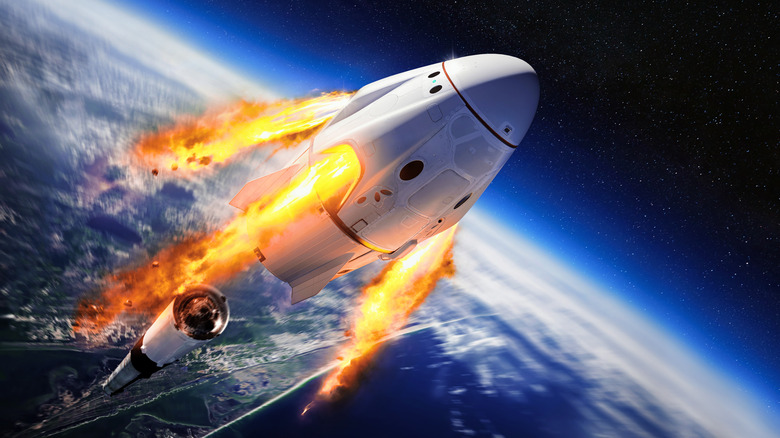Rocket Engines Produce Enough Heat To Melt Virtually Anything
Rocket engines are extremely hot, so hot that they can melt steel inside their own blast chambers. In rocket engines, combustion temperatures are around 5,800 F (via the McNally Institute). This is an immense amount of heat, and is about half the heat of the surface of the Sun, which is around 10,000 F (via NASA). This means that rockets produce enough heat to melt virtually any material we can think of.
Rocket engines must be able to reach these almost unfathomably high temperatures in order to function properly, and being able to create rockets that get even hotter may be essential for the future of space travel (via Everyday Astronaut). So how do rockets keep from overheating and melting their own materials? Engineers work endlessly to create cooling methods that keep the heat of the engine from melting away the rest of the rocket and everything inside of it.
Rocket engines using cooling methods to keep from melting themselves
There are several cooling methods that engineers use to cool rockets. One way that they do this is by making the walls of the blast chamber thicker, acting as something called a heat sink (via Everyday Astronaut). These heat sinks are capable of handling the intense heat longer, until the metal they are made of reaches its boiling point. Heat sinks are mostly used in smaller engine types, because they increase the weight of the rocket significantly when used in the main propulsion engines.
One of the most simple cooling methods for rocket engines is known as ablative cooling. This method involves a material that will vaporize when the engine is on, throwing it out. This vapor will take heat away from the engine along with it, helping to cool the rocket.
The most common method of cooling is known as regenerative cooling, which involves sending propellant through the walls of the combustion chamber before going into the chamber. Since this propellant has not been used yet, it is cooler than the chamber, drawing some of the heat away. This method is so effective that it can allow rocket engines to run for long periods of time without overheating.
Future rocket engines may get even hotter
The higher the temperature is, the more efficient a process will be. This is especially true for rockets, which require a lot of energy in order to work against Earth's gravity. This means that future rocket engines may need to get even hotter in order to become more efficient and cost effective. However, this also means that cooling methods will need to improve as well, as more heat causes the strength of materials in the rocket to decrease (via the McNally Institute).
New rocket engines, like SpaceX's Raptor 2, can produce so much heat that their chambers melt quickly. According to Elon Musk, "that [engine] really wants to melt, it's got like on the order of a gigawatt of heat, so it's pretty hot, like a gigawatt is what a nuclear power plant produces, so it really desperately is trying to melt at any point in time" (via NASA Spaceflight). As newer engines are developed for rockets, new and improved cooling methods will need to be added to prevent the engine from melting when used.


